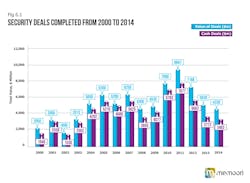In the last six years, mergers and acquisitions (M&A) within the security industry has, for the most part, been driven by the major conglomerates through strategic buys to acquire new technology, expand their product range, or improve focus on particular vertical markets and regions in the world where demand is growing.
However, within the last four years, their interest has all but disappeared. This has coincided with the fact that within the last two years, there has been a significant trend for medium-sized specialist companies (previously totally dependent on organic growth) to adopt strategic acquisition to speed up growth.
These companies are much more focused within each of the three major product segments (access control, video surveillance and intruder alarms) and this is having a significant impact on the structure of the market as we show in our 2014 Annual Report.
The chart above shows that the volume of acquisitions has fallen from its peak in 2011 by more than 50 percent in 2014. This year the proportion of external buys, which accounted for 30 percent in 2013, has contributed just one deal (four percent) - that being Nest Labs (Google) acquisition of Dropcam Inc.
Private equity buys was almost off the radar in 2010 and 2011, but accounted for five percent of the business in 2013. This year private equity has, through acquisition, pumped in approximately $2 billion, which equals 46 percent of the total value of acquisitions in the physical security business. Almost all of this was Carlyle’s acquisition of Tyco’s Fire and Security operation in South Korea.
Past history of major strategic deals shows in 2009/2010 when Schneider Electric acquired Pelco and UTC purchased GE Fire & Security. Safran purchased GE Homeland Protection in 2009 and continued this strategy with the purchase of L1-Identity Solutions in 2010.
With the exception of Tyco and Stanley, none of the incumbent major conglomerates have made any significant acquisitions in the last four to five years. This is very surprising given that acquisition has always featured high on their growth agenda.
Siemens finally sold off their security products business, a rumor that was raised many times over the last seven years. Not surprisingly, it was not picked up by any of its conglomerate rivals but by Vanderbilt Industries.
Cross border acquisition would appear to be the most likely driver for the major conglomerates to return to the dealing table. Our report shows the enormous latent potential in the Chinese market, which is not being maximized by leading edge western technology companies.
At the same time Chinese companies are relatively weak in IP technology and this could in time erode their share of the western market and eventually their home market share if it is not corrected. However, as the majority of business in China is in the public sector, they have time to correct this. Equally, this could be a solution to remedy western companies’ lackluster performance in the burgeoning China market.
Public equity will continue to dominate the M&A scene for the next few years. Private equity has in the past been a major source of funding for acquisitions but since 2012/2013 it has declined, although as we have already pointed out, one very large single private equity deal, namely Carlyle’s purchase of Tyco’s South Korea business, accounted for 46 percent and this has distorted the figures for this year.
About the Author

Jim McHale
Managing Director, Memoori
Jim McHale is managing director of Stockholm-based market research firm Memoori.
